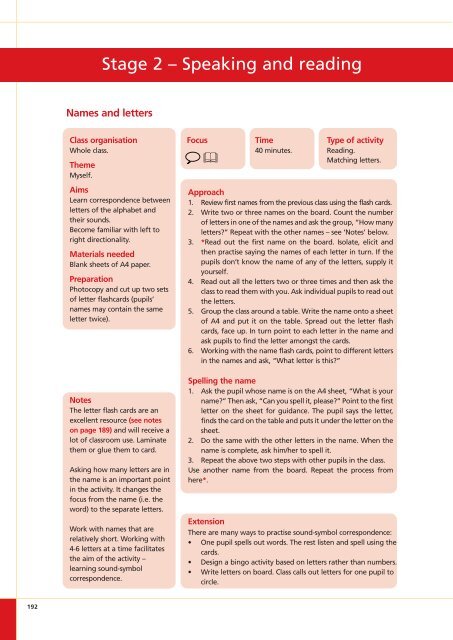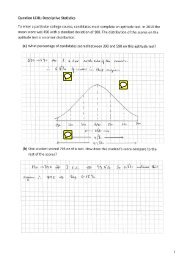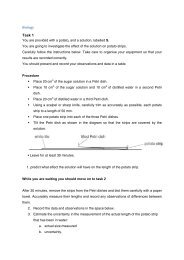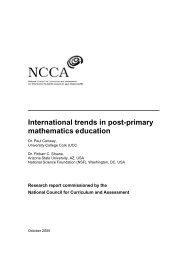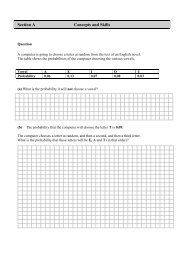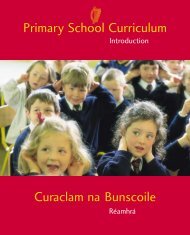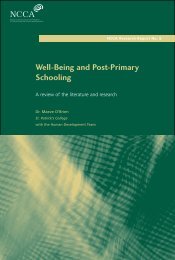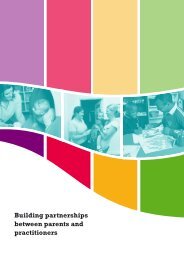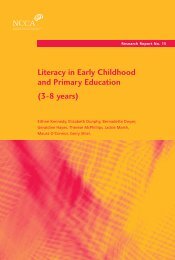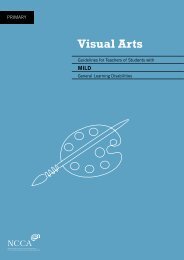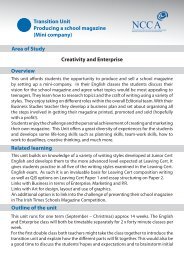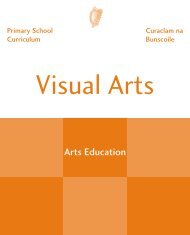Up and Away - National Council for Curriculum and Assessment
Up and Away - National Council for Curriculum and Assessment
Up and Away - National Council for Curriculum and Assessment
Create successful ePaper yourself
Turn your PDF publications into a flip-book with our unique Google optimized e-Paper software.
192<br />
Stage 2 – Speaking <strong>and</strong> reading<br />
Names <strong>and</strong> letters<br />
Class organisation<br />
Whole class.<br />
Theme<br />
Myself.<br />
Aims<br />
Learn correspondence between<br />
letters of the alphabet <strong>and</strong><br />
their sounds.<br />
Become familiar with left to<br />
right directionality.<br />
Materials needed<br />
Blank sheets of A4 paper.<br />
Preparation<br />
Photocopy <strong>and</strong> cut up two sets<br />
of letter flashcards (pupils’<br />
names may contain the same<br />
letter twice).<br />
Notes<br />
The letter flash cards are an<br />
excellent resource (see notes<br />
on page 189) <strong>and</strong> will receive a<br />
lot of classroom use. Laminate<br />
them or glue them to card.<br />
Asking how many letters are in<br />
the name is an important point<br />
in the activity. It changes the<br />
focus from the name (i.e. the<br />
word) to the separate letters.<br />
Work with names that are<br />
relatively short. Working with<br />
4-6 letters at a time facilitates<br />
the aim of the activity –<br />
learning sound-symbol<br />
correspondence.<br />
Focus Time<br />
40 minutes.<br />
Type of activity<br />
Reading.<br />
Matching letters.<br />
Approach<br />
1. Review first names from the previous class using the flash cards.<br />
2. Write two or three names on the board. Count the number<br />
of letters in one of the names <strong>and</strong> ask the group, “How many<br />
letters?” Repeat with the other names – see ‘Notes’ below.<br />
3. *Read out the first name on the board. Isolate, elicit <strong>and</strong><br />
then practise saying the names of each letter in turn. If the<br />
pupils don’t know the name of any of the letters, supply it<br />
yourself.<br />
4. Read out all the letters two or three times <strong>and</strong> then ask the<br />
class to read them with you. Ask individual pupils to read out<br />
the letters.<br />
5. Group the class around a table. Write the name onto a sheet<br />
of A4 <strong>and</strong> put it on the table. Spread out the letter flash<br />
cards, face up. In turn point to each letter in the name <strong>and</strong><br />
ask pupils to find the letter amongst the cards.<br />
6. Working with the name flash cards, point to different letters<br />
in the names <strong>and</strong> ask, “What letter is this?”<br />
Spelling the name<br />
1. Ask the pupil whose name is on the A4 sheet, “What is your<br />
name?” Then ask, “Can you spell it, please?” Point to the first<br />
letter on the sheet <strong>for</strong> guidance. The pupil says the letter,<br />
finds the card on the table <strong>and</strong> puts it under the letter on the<br />
sheet.<br />
2. Do the same with the other letters in the name. When the<br />
name is complete, ask him/her to spell it.<br />
3. Repeat the above two steps with other pupils in the class.<br />
Use another name from the board. Repeat the process from<br />
here*.<br />
Extension<br />
There are many ways to practise sound-symbol correspondence:<br />
One pupil spells out words. The rest listen <strong>and</strong> spell using the<br />
cards.<br />
Design a bingo activity based on letters rather than numbers.<br />
Write letters on board. Class calls out letters <strong>for</strong> one pupil to<br />
circle.


